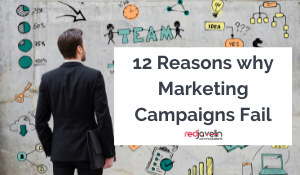 There are so many reasons why marketing campaigns fail. We rounded up twelve surprising reasons specifically for this post. I am sure there are items on this list that you had no idea affected your campaign. Let’s take a look.
There are so many reasons why marketing campaigns fail. We rounded up twelve surprising reasons specifically for this post. I am sure there are items on this list that you had no idea affected your campaign. Let’s take a look.
What is a campaign?
First, let’s define what a marketing campaign is and what it isn’t. Marketing campaigns are organized efforts to promote a specific goal, such as introducing a new product, increasing sales of a particular service, driving downloads of an ebook, or growing a social media following or email subscriber list. Campaigns aim to reach a specific audience in various ways and involve a combination of media, including but not limited to email, public relations, advertising, pay-per-click, and social media.
Campaigns aren’t a one-off marketing effort. For example, a LinkedIn ad would typically be only one tactic of an overall marketing campaign. It would be combined with downloadable content, email marketing for nurturing, blog post or news release for more awareness, PPC, and possibly organic social. LinkedIn is just one channel used to get your message to prospects. It is a great social platform but many people outside of marketing and sales do not frequent LinkedIn unless they are looking for a new job. So, if you are running a week long ad on LinkedIn, it is likely that your targeted audience will not see your ad or take action since they may be focused on looking for a new job or are leaving their current position. If you augment that with other tactics such as a sponsorship of a newsletter or ad in a vertical publication, you will have a better chance at getting in front of your potential prospects.
Twelve reasons why campaigns don’t meet their objectives
- Weak web presence – As they say, first impressions are lasting impressions, and your website is the first thing potential buyers see when they are researching your product and services. According to the recent 2021 IDG Customer Engagement research, 72% of tech buyers are more likely to consider a vendor who educates them through each stage of the decision process. In this day and age of online everything, some companies still have a Web 1.0 mindset. Their website is strictly “brochureware” meaning it doesn’t lead a customer through a story or journey. These companies have not invested in a web strategy and their website is not sales-ready. They don’t rank for any keywords or have a solid social presence. A strong web presence is table stakes in today’s digital world.
- Lack of quality content – These days, people will not give you their information if you aren’t offering something they want. In the 2021 IDG Customer Engagement survey mentioned above, 87% of technology buyers stated they are willing to register for content; however, only 41% of downloaded work-related content provided buyers with value over the past 12 months. Your content needs to be valuable and digestible. Learn more about the power of eBooks here.
- Your message/creative doesn’t resonate with your targeted audience – Either your message is too complex, or you have missed the mark in terms of understanding your customer pain points. Or, your audience isn’t seeing your message enough. We still use the Rule of 7 – someone needs to hear your message seven times before they can recall it. If it is not clear, too complicated, or if people don’t see it repeatedly, they will likely not engage with you.
- You misread market readiness – We see this frequently with our start-up clients. They have developed a product based on some new technology, and they are early to market or are trying to solve a problem that either doesn’t exist or is not well understood. Generating sales leads, specifically buyers entering the sales cycle, is very difficult when the technology has not crossed the chasm or not well understood.
- Expecting immediate results – Many campaigns fail because you don’t give them enough time. Campaigns take time to see results. For example, you may not see the results of an SEO campaign for six months or longer. We have a client where the goal was to have more organic traffic than web traffic. It took five months to reach that goal using a combination of tactics.
- You are not taking an integrated approach – This is a big one. If you are only using one tactic, then it is likely that you will not reach your goals. You need to take an integrated approach and include several channels into your program. For example, social media ad reach is dependent on how often your audience visits/uses social media. Many B2B buyers do not use social media daily, and that is why you may want to also consider earned media to expand the likelihood of your targeted audience receiving your message.
- You are trying to accomplish too many goals with one campaign – Diluted campaigns rarely succeed. Common goals of campaigns include promoting a new product or service, Increasing brand awareness, gather customer feedback, generate revenue, boost user engagement, or advertise an upcoming event When you try to accomplish too many things with one budget and one campaign it is likely to miss the mark. The message becomes diluted. Stick to one goal per campaign.
- You don’t understand your customer journey - Even if you create the perfect campaign and message, it won’t lead to success if your message isn’t delivered to the prospect at the right time. You need to have a good understanding of your prospect and their purchasing patterns, which requires research, tracking, and analyzing customer engagement to understand the buyer’s purchasing journey.
- Marketing and sales are not aligned - Successful lead follow-up can make or break a campaign. Your marketing will be more effective if your programs are aligned with the sales team and you agree on what constitutes a sales lead and the process of handoff between the organizations. In addition, the sales team will be able to feed pertinent information throughout the campaign on what is resonating with prospects and what isn’t working.
- Product quality/failure – Don’t over promise and under deliver. Ensure your product is shipping and ready to go when you launch your campaign. The quickest way to undermine customer/market trust is to not be able to deliver product when you have just promoted it or to deliver a product that really isn’t ready yet.
- Your strategy isn’t aligned with your tactics –. Your strategy is the game plan and tactics are the plays out of your playbook. Sometimes executives will request a specific tactic because they heard at a conference or from a friend that it works. If the tactic doesn’t align with your strategy, then chances are it will not achieve the desired result.
- You are using too many disparate systems to execute and measure your campaign - This is a big one and I am going to go into detail on this topic in my next post. As organizations scale, they add to their technology stack. Simultaneously, sales and marketing activities often use different tools, making it hard to gain a 360° view into prospect activity and interest. Assets and data can be housed in dozens of systems. Your emails are sent from one platform, your website and conversation data is stored in another, and sales is working out of a third causing misalignment and siloes across the organization. Getting a single view into the customer experience becomes near impossible, and reporting fails to tell the full story due too unreliable data. If you’re basing your campaign and results on unreliable data, it is a set-up for failure.




